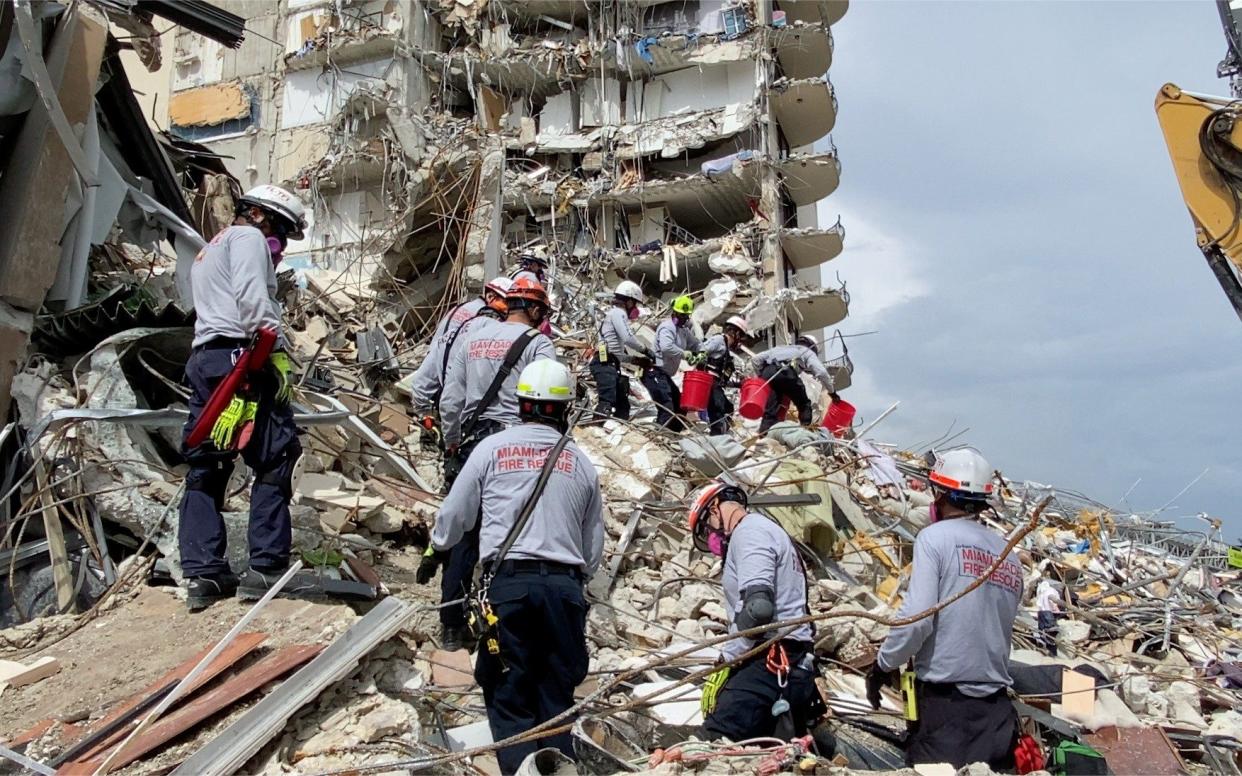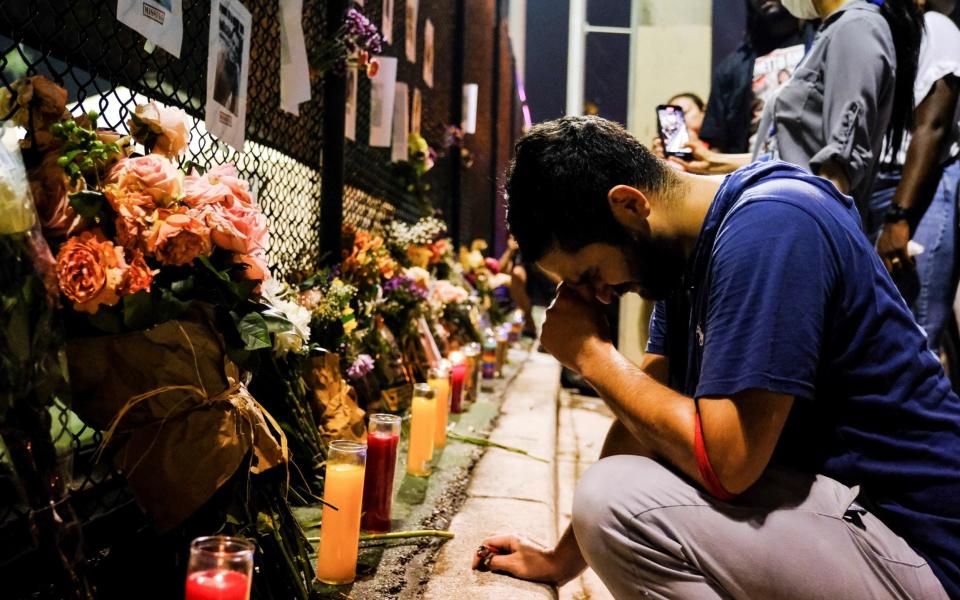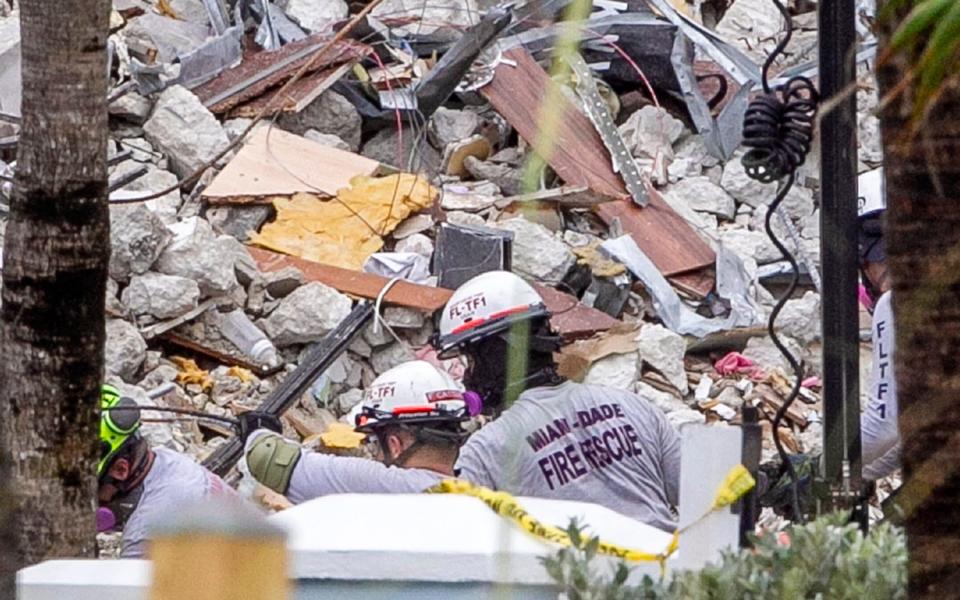Dwindling hope for 159 missing in Miami building collapse as scientists dispatched to structural problems

A team of US government scientists and engineers has been flown to Miami to urgently assess whether the collapse of an ocean front apartment block should trigger a wider investigation that could change building regulations across the country.
Officials said 159 people are still unaccounted for, including a British woman and her family, after the 12-storey building collapsed in the early hours of Thursday. No-one was found alive on Friday.
The Foreign Office said they are supporting the family of a British woman, who media identified as Bhavna Patel, a 38-year-old dual British-US national who is missing along with her husband and daughter.
Ms Patel, her husband Vishal and daughter Aishani were staying at the Champlain Towers South building when it fell, according to a family member.
As search and rescue crews continue to battle fire, smoke, torrential rain and falling debris, their focus is starting to shift to recovery, given that 48 hours have now passed since the building collapsed.
"You gotta have hope. We're doing everything we can to bring your family members out alive," Miami-Dade Fire Rescue chief Andy Alvarez told the loved ones of the missing on CNN, recounting that his team once pulled a girl out of earthquake debris in Haiti eight days into the rescue effort.
Teenager Jonah Handler was rescued from the rubble hours after the collapse, but his mother, Stacie Fang, died. Relatives issued a statement expressing thanks "for the outpouring of sympathy, compassion and support we have received."
"There are no words to describe the tragic loss of our beloved Stacie," it said.

The cause of the deadly incident is still not known, but experts fear that other buildings could be vulnerable to catastrophic structural failure if they have been built in the same way or stand in a similar location.
On Friday, the city of Miami’s building department announced it will request citywide inspections of all buildings six stories or taller that are 40 years or older.
What is known is that the building was about to undergo extensive repairs for corrosion and concrete spalling as part of a required structural re-certification for buildings that are 40 years old.
But other questions have been raised over land subsistence, flooding, the activity of nearby building sites and the possibility that a sinkhole opened up beneath the apartment block.
What happened?
At about 1.30am on Thursday morning 55 of the Champlain Towers South building’s 136 units fell to the ground in a pile of rubble and twisted metal.
It took just 21 seconds for the 12-storey tower to collapse. The central section caved in first. The rest of the block fell on top of it.
The building was described as having “pancaked” - where one floor can’t support the weight of the one above and they fall through.
“It looks like a bomb went off, but we're pretty sure a bomb didn't go off," said Surfside mayor Charles Burkett.
The building, which faces onto Surfside Beach in Miami was built in 1981 and was popular with tourists, who rented out apartments.
Among the missing are people from Israel, Paraguay, Uruguay, Argentina and the UK.
What could have caused the collapse?
"There's no reason for this building to go down like that unless someone literally pulls out the supports from underneath, or they get washed out, or there's a sinkhole or something like that, because it just went down,” said Mr Burkett.
Sources on the ground have told the Telegraph that they believe a sinkhole opened up beneath the apartment block, causing the centre to cave in.
“Have you seen the pile of rubble? It’s not that high. Where did 12 stories of rubble go?” said one person with knowledge of the search and rescue mission.
According to a study led by Florida International University environment professor Shimon Wdowinski, which used satellite radar data, the site showed signs of land subsidence as far back as 30 years ago.
"I don't know if the collapse was predictable. But we did detect that the building moved in the 1990s," Mr Wdowinski told CNN on Friday.
"It's very subtle. It's two millimetres per year but it's still detected by the satellites," he explained.
Matthys Levy, a consulting engineer and professor at Columbia University told USA Today that even the minor subsidence detected could have an impact.
"A millimetre may seem like a small number, but when you add them up over many years, it becomes a big number," Mr Levy said, pointing to the fact that one part of the building is still standing as potentially significant.
If one part of a building is well-founded and the other is not, he explained, it can cause distortion in the floor slabs and "suddenly, you get cracking, breaking and fracturing."
That can lead to what is called progressive collapse - as happened during the September 11 attacks in New York.
"If one part of the building fails, it drags the rest with it," Mr Levy said. "There's nothing there to stop it, there's no strong elements to hold it back. It's a cascade."
Other theories have been put forward.
The building was about to be repaired for rusted steel and damaged concrete, according to a lawyer involved in the project.
Salt water from the sea can penetrate buildings and corrode steel elements. Sitting on the oceanfront for 40 years, the Champlain Towers South building has been exposed to hurricanes and flooding - both of which brought sea water onto the complex.
Work on the building’s roof was underway, but experts have cautioned that this in itself is not likely to have caused the collapse.
There have been other complaints from residents. One filed a lawsuit over water intrusion that she blamed on poor maintenance.
Other residents have complained that nearby construction had sent rumbles through the structure, potentially unsettling the foundations, according to the New York Times.
What was the inspection process?
In 1992, Hurricane Andrew devastated swathes of south Miami coastline causing $34 billion in damage. 63,000 homes were destroyed and another 100,000 damage, with the hurricane exposing just how poorly many had been built.
As a result, new, much more rigorous building regulations were introduced designed to protect apartment blocks, houses and offices against extreme weather.
But the Champlain Towers South building went up in 1981. Old regulations meant that it was not due to be re-certified until this year.

Reacting to the collapse, and fearful of any more, the city of Miami’s building department announced on Friday that it will request citywide inspections of all buildings six stories or taller that are 40 years or older.
But some experts say the current inspection process isn’t deep enough, because it doesn’t account for the effects of sea level rise, floods and tides over the decades since older buildings were built.
The majority of residential towers in Miami-Dade - 70.2 per cent - were built before 1990.
“Everyone associates Miami with beautiful glass and steel buildings,” David Haber, managing partner of Haber Law, a construction and real estate firm, told the Miami Herald.
“But we have a lot of concrete buildings just like the Champlain towers that are nearing the 40-year re-certification process.
“I’m getting condo boards asking me what they should be doing. Their residents are asking ‘Is my building safe?’ It’s the first logical question anyone living in those concrete buildings would ask.”
Will there be a full investigation?
"We need a definitive explanation for how this could have happened," Governor Ron DeSantis told a news conference.
"I do think it's important that it's timely," he added, "so that we get the answers to the families and that we get the answers to the people of Florida."
Atorod Azizinamini, chair of FIU’s civil and environmental engineering department, said structural engineers would collect vast quantities of data on the building's design plans and construction methods.
They will take samples of steel and concrete, look at signs of corrosion, examine the foundation for signs of settlement, and try to detect any unusual event before the collapse.

"Once we have all the information we can simulate exactly different scenarios, and we can pinpoint how the collapse took place," Mr Azizinamini said.
"Unfortunately that is not going to be happening in a matter of days, weeks."
"It's going to take some time."
The federal scientists and engineers sent down to Miami have a different task.
National Institute of Standards and Technology spokeswoman Jennifer Huergo stressed that while this team is only looking to determine if an investigation will be recommended and not the cause of the collapse, it does have the power to subpoena and they will gather building materials that could be helpful if a full federal investigation is deemed necessary.
“If a full investigation or study is conducted,” the agency said in a statement, “its ultimate goal would be to determine the technical cause of the collapse and, if indicated, to recommend changes to building codes, standards and practices, or other appropriate actions to improve the structural safety of buildings.”
The team will not interfere with the search for 159 people who are still unaccounted for.

